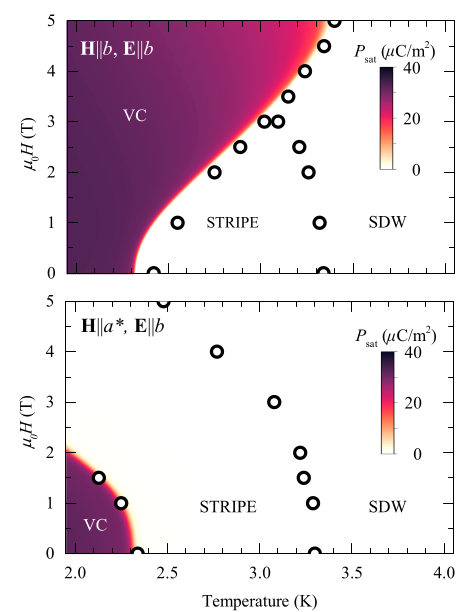This website uses cookies to ensure a better user experience.
To get more information, please read our Cookie Statement.
Control of a polar order in a vector chiral magnet
Our colleagues Martina Dragičević, David Rivas Góngora, Željko Rapljenović, Mirta Herak, Vedran Brusar, Damir Altus, and Tomislav Ivek, in collaboration with associates at JSI, Slovenia and EPFL, Switzerland, published an article on control of ferroelectricity in β-TeVO4, an antiferromagnetic material with spin spiral ordering.
Control of a polar order via magnetic field in a vector-chiral magnet
Martina Dragičević, David Rivas Góngora, Željko Rapljenović, Mirta Herak, Vedran Brusar, Damir Altus, Matej Pregelj, Andrej Zorko, Helmuth Berger, Denis Arčon, and Tomislav Ivek, Physical Review B 104, L121107 (2021).
DOI: 10.1103/PhysRevB.104.L121107
Magnetoelectrics are materials in which a magnetic ordering of spins and a ferroelectric ordering of electric dipoles exist simultaneously and are coupled. In the recent years, magnetoelectric candidates are being investigated belonging to the class of magnetic insulators in which ferroelectric polarization occurs due to the spin ordering. In particular, spiral ordering of spins may allow ferroelectricity to appear.
Quantum magnet β-TeVO4 is a spin chain where spins interact ferromagnetically with their first neighbours and antiferromagnetically with second nearest neighbours. Spins in such a system are said to be frustrated and are difficult to order. In this compound the ordering occurs only at very low temperatures, below 5 K. In the latest article, our colleagues provide direct experimental evidence that the so-called vector-chiral antiferromagnetic phase in β-TeVO4, is ferroelectric i.e. magnetoelectric. Completely unexpectedly, it was discovered that the “hardness” of the ferroelectric response significantly depends on the applied external magnetic field, which indicates a possible new way of controlling multiferroic domains. This research is of direct importance for development of new sensors and digital memories as well as improving our understanding of matter in extreme conditions.

Figure: Ferroelectric phase diagram β-TeVO4 for two orientations of magnetic field H compared with critical temperatures of magnetic phase transitions. Shading represents interpolated measured saturation polarization Psat for E||b, clearly demonstrating that the ferroelectric response appears only within the vector-chiral phase boundary. Circles denote critical temperatures determined by magnetic susceptibility from literature.




